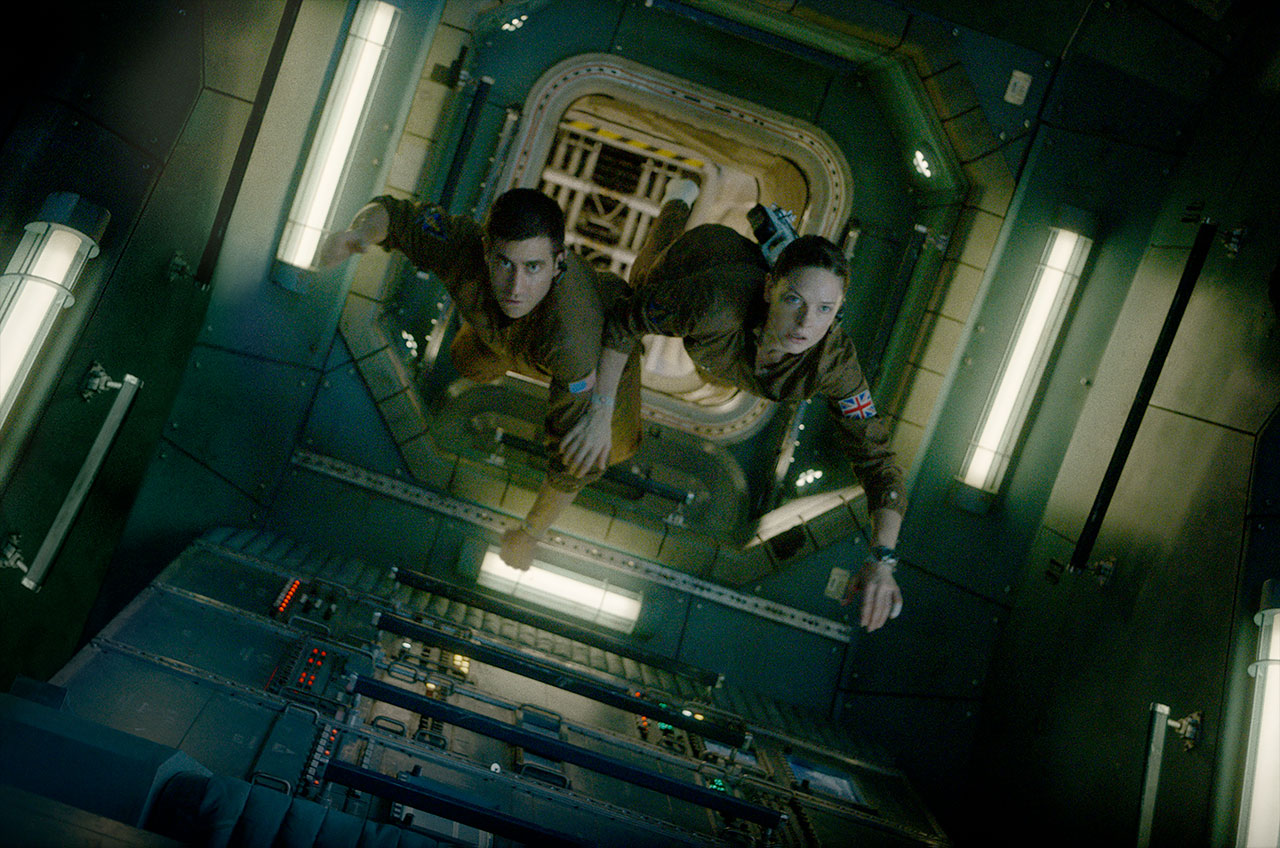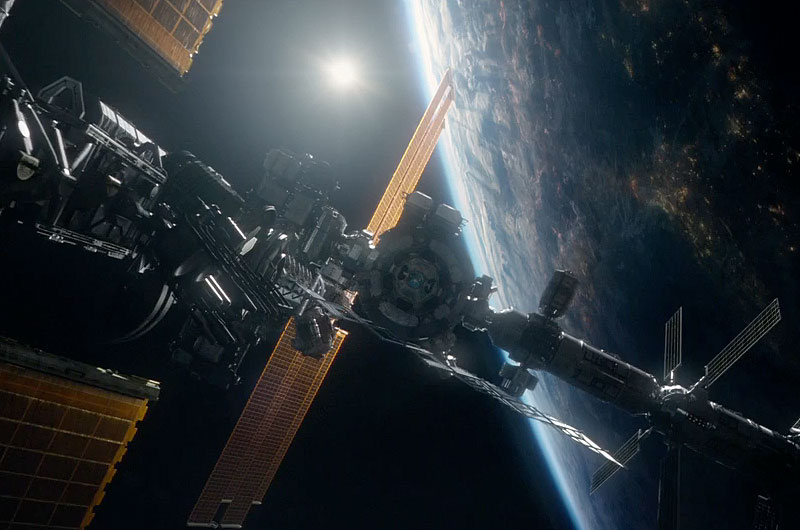'Life' on the Space Station: Stars, Director Talk About ISS in Sci-Fi Thriller

Daniel Espinosa believes NASA might forbid his new movie "Life" — which takes place on board the International Space Station — from being screened by the astronauts living aboard the real orbital outpost.
"I think it would give them a bit of nightmares!" the director said. "I would love that to happen, though."
Opening Friday (March 24) in theaters (on Earth), "Life" is a science fiction horror film that follows the plight of a crew on board the International Space Station (ISS) after a Mars sample return mission delivers a tantalizing payload to the orbiting lab. The astronauts and cosmonauts are played by Jake Gyllenhaal, Rebecca Ferguson, Ariyon Bakare, Ryan Reynolds, Hiroyuki Sanada and Olga Dihovichnaya in the Sony Pictures' movie. ["Life": A Space Thriller in Photos]
"I know there've been a lot of synopsis lines out there, but I think it's basically a crew on the ISS trying to find answers to a question thousands of people have wondered looking up: is there any kind of life form out there?" said Ferguson, who plays Miranda North, a microbiologist on loan to the crew from the Centers for Disease Control. "It's kind of research meets reason, spiced up with lovely moral dilemmas."
While a complete work of fiction, "LIFE" draws from reality and NASA's plans for the near future in order to heighten suspense and immerse the audience in a world that is as familiar as it is alien.
"It felt like we were just there," Bakare, who portrays Hugh Derry, a British scientist in charge of analyzing the Martian sample, described to collectSPACE. "Around every corner, everywhere you looked, it was just 'this is a space station.' You never found yourself outside of that reality."
Great inspiration
"It was quite fun to get into this world, where on one hand you envision every sequence that I have [in the movie] and then let that meet the reality of what my research people would tell me of the ISS," said Espinosa. "It then became a tug of war of what actually got done."
Breaking space news, the latest updates on rocket launches, skywatching events and more!
"Making it as real as possible within the realms of a movie was one of the great inspiration pieces to make 'Life,'" he said.
Audiences who are familiar with the real space station will recognize some of the equipment and components used in orbit today. The filmmakers began with the configuration of the space station as it exists now and then extrapolated for the story they were telling.
"We spoke to people with NASA to estimate for if you were to get a sample from Mars, how long would it actually take to get to ISS?" Espinosa explained. "They said about six to seven years."
Espinosa worked off the premise that if scientists had hints of Martian life and wanted to employ the space station as a quarantine to protect everyone on Earth while studying the sample, then it would stand to reason that the orbiting lab would be modified in the interim to meet that objective.
"We did an estimate of how much you'd build. We spoke to people who were involved with the construction of the ISS to get an estimate of what you would work on," he said. [Building the International Space Station (Photos)]
Subtle details
Forgoing CGI for a physical set ("I think something gets a bit lost in the surreal environment of a green screen," said Espinosa), the space station in "Life" was built in London.
"If you like the station, we literally had a replica," Ferguson said. "Nigel Phelps, our production designer, built the ISS, and I am not just talking about the shield. I am talking the cables, wires, buttons, things that twist and turn... I do not know why they twisted and turned, but goodness they had a good twist and turn effect."
"There were also buttons everywhere we were not allowed to press but everyone was pressing all of the time because apparently, we are all still children," she said, laughing.
And then there were the spacesuits — costumes that were based on NASA's extravehicular mobility unit and Russia's Sokol launch and entry pressure suit.
"Our costume designer, Jenny Beavan, made replica outfits and the watches we wore had been to space. So we kind of felt a bit like astronauts, but at the same time not even close," Ferguson said.
Beyond the accuracy of their surroundings and wardrobe, the cast had to convey being in space by how they moved in simulated weightlessness.
"The difficulty was we were on wires, balancing, because we weren't really in zero gravity," said Bakare.
"It was very hard hanging in these harnesses and trying to look effortless and weightless and then on top of all of that, trying to remember your lines as well," added Ferguson.
"So what I thought was lovely was something Daniel said," she continued. "Jordan, so Jake's character, he has been up there for the longest, so he has kind of molded into the ISS. So how does a person who has been up there in this environment for so long, how does he move compared to Miranda, a microbiologist? How does she move if she has basically only been there for a couple of weeks?"
"And that is fun. The tiny, tiny, subtle details of movement," said Ferguson.
Fear of the unknown
Ultimately though, "Life" is less about the fun and wonder of spaceflight as it is about the fear it sometimes evokes.
"It is about fear. Fear for one's self, fear for your crew, and fear for the billions of people on Earth," said Bakare.
"I think it is meant to explore man's need to survive and it deals with the rational and irrational sides of the psyche," he explained. "We are all searching to survive and to get a longevity of life. The reason we are exploring space is for us to find more ways to keep the human race going."
"I think what is scary for people is we have the knowledge of the not knowing," noted Ferguson. "Usually, we human beings fear what we don't know, and that is why we try to contain it, try to control it and try to maneuver it and make it our own. And then gradually, we take away the fear."
"In many of ways, this is not about what the unknown does to us, but what we do to the unknown," said Espinosa. "So in that way, 'Life' is about the responsibility we have when something starts to exist — our responsibility to treat new encounters with curiosity and openness.”
Watch an extended sneak peek of "Life" from Sony Pictures at collectSPACE.
Follow collectSPACE.com on Facebook and on Twitter at @collectSPACE. Copyright 2017 collectSPACE.com. All rights reserved.

Robert Pearlman is a space historian, journalist and the founder and editor of collectSPACE.com, a daily news publication and community devoted to space history with a particular focus on how and where space exploration intersects with pop culture. Pearlman is also a contributing writer for Space.com and co-author of "Space Stations: The Art, Science, and Reality of Working in Space” published by Smithsonian Books in 2018.
In 2009, he was inducted into the U.S. Space Camp Hall of Fame in Huntsville, Alabama. In 2021, he was honored by the American Astronautical Society with the Ordway Award for Sustained Excellence in Spaceflight History. In 2023, the National Space Club Florida Committee recognized Pearlman with the Kolcum News and Communications Award for excellence in telling the space story along the Space Coast and throughout the world.


